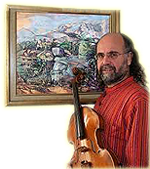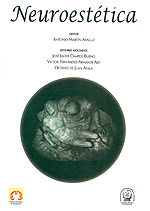Pictomusicadelfía español/ ENGLISH
Pictomusicadelfía
Término acuñado por el violista e investigador Dr. Octavio de Juan Ayala en su Tesis Doctoral con Mención Europea (en idioma alemán) leída en la Universidad de Murcia el 25 de Octubre de 2010, para designar el hermanamiento o interrelación entre la Música y la Pintura a través del análisis de los recursos técnicos y expresivos. Fue concebida como herramienta metodológica y conceptual en la búsqueda de tres interrogantes: la posible existencia de un correlato neuronal musicopictórico determinado, es decir, un itinerario o camino de encendido neuronal específico cuando vemos pintura y escuchamos música simultáneamente; la segunda, si existen unos universales en la Música y en la Pintura, es decir, unos elementos, componentes o conceptos que, por sí solos, aislados o en unión con otros, puedan provocar los mismos efectos emocionales en las personas, con independencia de razas, continentes o religiones.
El tercer gran interrogante sería si estaría justificado, desde el punto de vista fisiológico, el posible fenómeno de la evocación entre la Música y la Pintura.
Los nuevos enfoques y datos han sido elaborados a través de estudios experimentales conductuales, electrofisiológicos con electroencefalografía (EEG) y de neuroimagen, con resonancia magnética funcional (fMRI) llevados a cabo hasta la fecha en la Facultad de Psicología de la Universidad Complutense de Madrid, la Universidad de las Illes Balears de Palma de Mallorca y en el Institut für Medizinische Psychologie und Verhaltensneurobiologie de la Universidad de Tübingen (Alemania), donde, y respectivamente, han tenido una participación decisiva, además del autor, su Grupo de Trabajo, formado por el Profesor Javier Campos Bueno (Universidad Complutense de Madrid) y el Profesor Pedro Montoya (Universidad de las Illes Balears de Palma de Mallorca), con la supervisión del eminente Profesor Niels Birbaumer (Institut für Medizinische Psychologie und Verhaltensneurobiologie de la Universidad de Tübingen (Alemania)).
El vocablo Pictomusicadelfía (picto-music-adelfía) contiene, amén de las cinco primeras letras de cada uno de los adjetivos pictórico y musical respectivamente, y por ese orden, lo que puede resultar una obviedad, el término de nueva creación adelfía, que proviene del sustantivo del griego moderno αδελφός, ού, que significa “hermano”. Este sustantivo resulta de la derivación del sustantivo de igual significado del griego clásico αδερφός, ού verificándose un proceso de palatalización de la letra r por la letra l, con lo que la fonética gana en suavidad. Y esa fue la razón por la que adoptamos la versión moderna y no la clásica para la fonética del sustantivo griego y, por ende, de nuestro término completo.
Así pues, la definición parcial del término sería la de “hermanamiento a través de la Pintura y de la Música” o “hermanamiento músico pictórico”. La traducción original del la palabra hermanamiento al griego moderno es αδελφοποίηση, pero la hemos rechazado tanto por su longitud como por su dificultad de pronunciación, al menos, para un desconocedor de la lengua griega moderna.
Las razones antes aludidas a la conveniencia de esta denominación son las siguientes:
1) la sinergia que resulta de la fundición de 8 palabras y 38 letras (la interrelación entre la Música y la Pintura) en una sola palabra de 17 letras.
2) aunque su valor denotativo sólo abarque 8 palabras (la interrelación entre la Música y la Pintura), su valor connotativo y, creemos, más específico, concreto y original, engloba a otras 10 más (a través del análisis de los recursos técnicos y expresivos) o sea, en total, 18 palabras y 88 letras fundidas en una sóla de 17 (estamos en tiempos de crisis…).Y es ésta la razón fundamental por la que estamos convencidos se justifica esta nueva denominación, si somos coherentes con lo que se ha expuesto en los párrafos precedentes.
Son muchas y variadas las aproximaciones teóricas y experimentales que se han producido entre la Música y la Pintura y su relación con el cerebro desde el punto de vista de la psicología experimental o de la neurología. Como referiremos posteriormente, también se han dado pasos en la interrelación entre la Música y la Pintura al mismo nivel. Pero lo que hasta ahora no se había propiciado era esta interrelación a través del utillaje proporcionado por el minucioso análisis de cada uno de sus componentes, de la interacción entre ellos y el enfoque de cómo éstos provocan, a su vez, una determinada respuesta emocional.
Y por ello consideramos honestamente, que esta denominación Pictomusicadelfía, lejos de suponer un atrevimiento lingüístico, que lo es, nos proporcionar una herramienta semántica que pueda operar en pos de la concreción y definición de su significado y la evitación de malentendidos y ambigüedades. Es decir, que con ella tan sólo se pretende ofrecer una herramienta útil para explorar las emociones de nuestro cerebro.
Pictomusicadelfia english version
Term coined by the violist and scientist (researcher) Dr.Octavio Juan Ayala in his doctoral thesis with European Mention (in German) read at the University of Murcia on October 25, 2010, to describe the twinning relationship between music and painting through the analysis of technical and expressive resources. It was conceived as methodological and conceptual tool in the pursuit of three questions: the possible existence of a determined musicpictorial neural correlate, ie, a route or specific neuronal path when we are seeing paintings and hearing music simultaneously, and second, whether there are universal in Music and Painting, ie, elements, components or concepts that, by themselves, alone or in conjunction with others, to cause the same emotional effects on people, regardless of races, continents and religions.
The third big question is whether it would be justified from the physiological point of view, the possible phenomenon of evocation between music and painting.
In the new approaches and data that have been developed through experimental behavioral works (studies), electrophysiological ones, with electroencephalography (EEG) and of neuroimaging with functional magnetic resonance imaging (fMRI) conducted to date in the School of Psychology Complutense University of Madrid, the University of the Balearic Islands of Palma de Mallorca and Institute of Medical Psychology and Behavioral Neurobiology Institut für Medizinische Psychologie und Verhaltensneurobiologie of the University of Tübingen (Germany), respectively, have been very active in addition to the author, its Working Group, formed by Professor Javier Campos Bueno (Universidad Complutense de Madrid) and Professor Pedro Montoya (University of the Balearic Islands of Palma de Mallorca), under the supervision of the eminent Professor Niels Birbaumer (Institut für Medizinische Psychologie und Verhaltensneurobiologie of the University of Tübingen (Germany)).
The word Pictomusicadelfía (Pict-music-Adelfia) contains, besides the first five letters of each of the adjectives pictorial and musical respectively, and in that order, which may be obvious, the newly created term “Adelfia”, which comes from the modern Greek noun αδελφός, ού, meaning “brother.” The substantive results from the derivation of the meaning of the same substantive of the classical Greek αδερφός, ού verifying a process of palatalization of the letter “r” with the letter “l”, thus gaining in phonetic smoothness. And that was the reason why we adopt the modern version and not the classical Greek phonetics noun and, therefore, our full term.
Thus, the partial definition of the term would be “twinning of Painting and Music” or ” music pictorial twinning.” The original translation in modern Greek of the word “twinning” is αδελφοποίηση, but we have rejected it both because its length and difficulty of pronunciation, at least for someone unfamiliar with the modern Greek language.
The reasons given above for the convenience of this description are as follows:
1) the synergy resulting from the smelting of 8 words and 38 letters (the relationship between music and painting) in a single word of 17 letters.
2) although its denotative value covers only 8 words (the interplay between music and painting), its connotative value and, we believe, more specific, concrete and original, includes another 10 more (through the analysis of the technical and expressive mediums) that is, a total of 18 words and 88 letters in a single word of 17 letters (we are in times of crisis …). And this is the fundamental reason why we believe this new name is justified, if we are consistent with what is discussed in the preceding paragraphs. There are many different theoretical and experimental approaches that have occurred between the music and painting and their relationship to the brain from the standpoint of experimental psychology or neuroscience. As will refer later, it have also taken steps in the relationship between music and painting at the same level. But what until now did not exist was this interrelationship fostered through the tools provided by the detailed analysis of each of its components, the interaction between them and focusing on how they cause, in turn, a certain emotional response.
And honestly, we consider that this designation Pictomusicadelfía, far from being a linguistic daring, that it is, we provide a semantic tool that can operate in pursuit of the realization and definition of its meaning and avoiding misunderstandings and ambiguities. That is, our only aim is to provide a useful tool to explore the emotions of our brain.



